Want more great
Catching Content?
Sign up for FREE and see everything we have to offer!
In my short 4-year coaching career, I have had the opportunity to work with all different types of Catchers with different skill sets of strengths/weaknesses. Because of these outstanding experiences with each individual, as a coach, I have had to mold into what personally is best for that specific Catcher.
I’m sure we can all attest to this, but I cringe at some of the things I used to teach just in previous years of my short 4 years as a collegiate coach (ex. Stick, big secondary stances, etc.). I’m a firm believer that the game is always evolving; therefore, as a coach, we must learn and adapt to what is going to put our players in situations to be successful.
At Charleston Southern University, we have adapted a Catching philosophy that in my opinion, is increasing our ability to impact the game from behind the dish and ultimately save the most runs. This isn’t the only way and by all means isn’t perfect because we are still learning ideas to improve our craft; however, we have seen success and it positively impacted our way in how we handle a pitching staff.
Background Information
Even though the 2020 season was shortened, we still have the ability to analyze the numbers and learn from what happened. At the basis of our catching philosophy, we take a deep look at the Skill Economy, or exactly how many times each skill takes place in the game. The reasoning behind this is to be great at the game of baseball and specifically as a Catcher, you must be good at the skills that actually occur in-game. This might sound elementary, but for many years emphasis has been put on skills that don’t necessarily occur that often or have little run value.
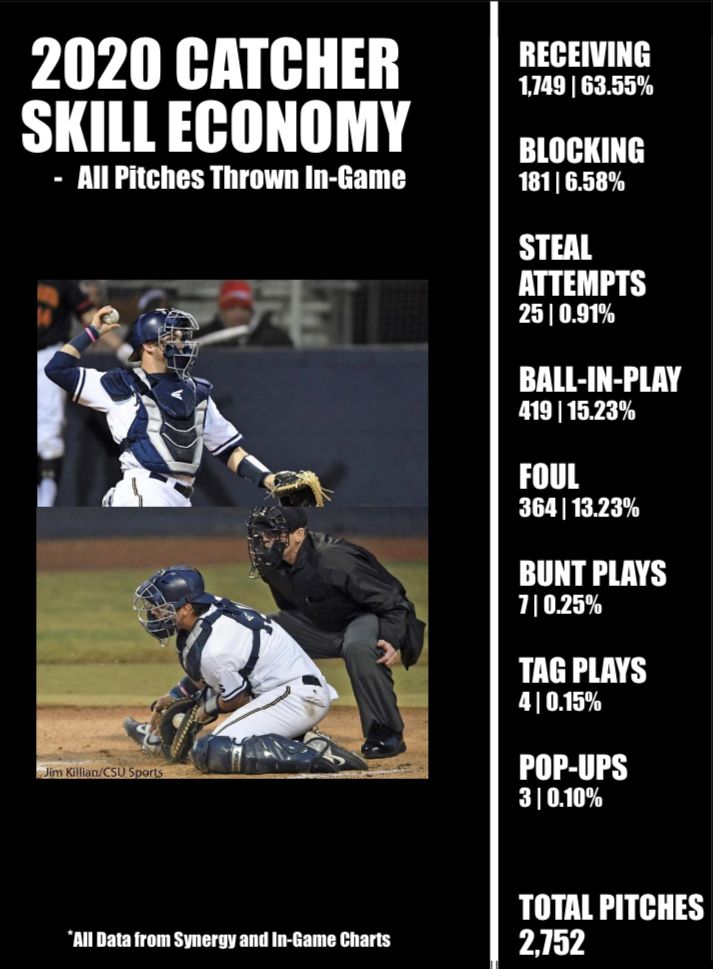
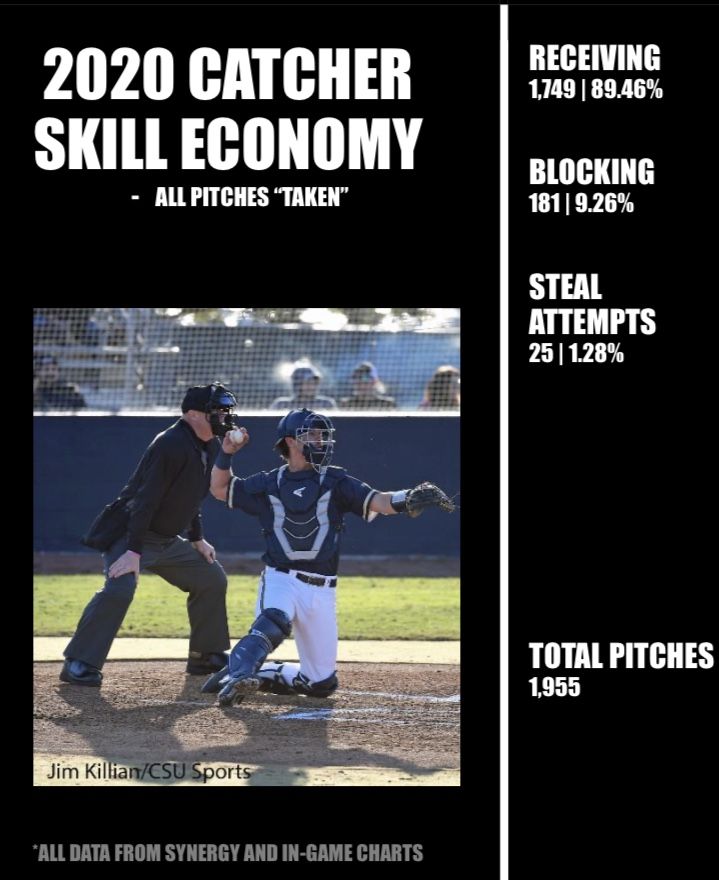
Through our 19-game 2020 campaign, the data listed above is exactly how many times each skill took place. To highlight some specific info from the 1st graphic, out of all pitches thrown in-game, we received 63.55% of the time. Another astonishing number is that we attempted to throw a runner out less than 1% of the time. Also, when one takes a look at the miscellaneous plays (bunts, tag plays, pop-ups), they all occurred at less than a 1% clip as well. Diving into the info on the 2nd graphic, out of all pitches “taken”, we performed a receive almost 90% of the time.
I understand this might be a small sample size because of the 19-game season due to COVID-19, so I took a look deeper into the year of 2019 for the Charleston Southern Catchers. For a disclaimer, I was not on the staff for the 2019 season; therefore, all the data solely originates from Synergy charts/breakdowns.
For the 2019 Spring campaign (below), the numbers vary by a few percent points. However, for the most part, they are roughly in the same ballpark area of the 2020 numbers.
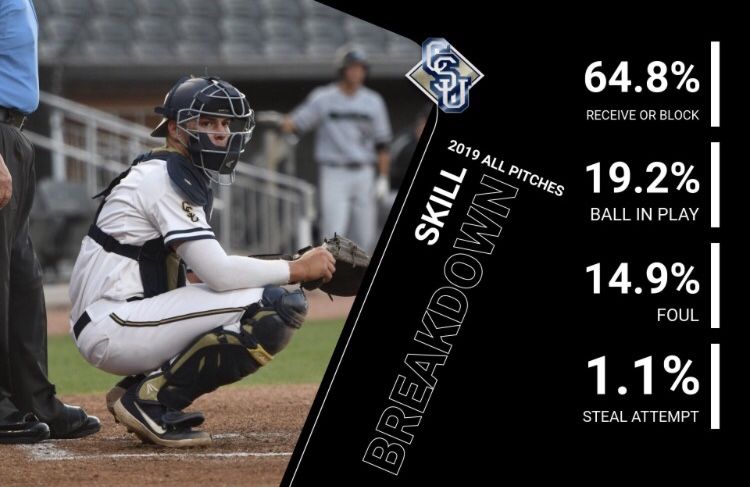
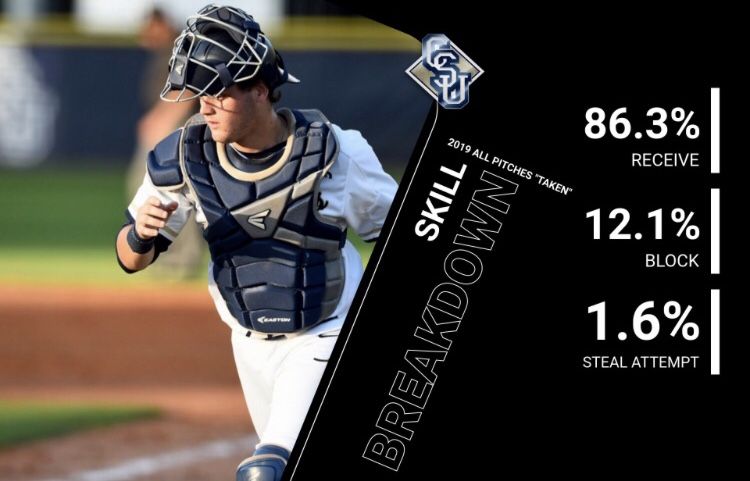
I strongly believe that to be a solid backstop in the current game today, you must be good at the skills that happen frequently and the most. These aren’t groundbreaking numbers because numerous other coaches have done their leg-work to analyze and evaluate how often skills happen in the current game. For the basis of a catching philosophy in terms of saving runs and impacting the game, I believe you must look at what happens in-game and alter your craft from that standpoint.
After reading over this data and talking with Zac Stout, I used his ideas/data concerning run values to try at best to objectify the performance of our Catchers. Zac has previously posted this, but here is a breakdown of the run value concerning each skill that I have borrowed from him and his research:
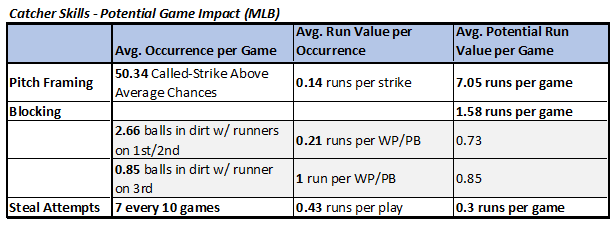
Learning Points and Conclusions
All the data is in front of us and we have formed the base of the pyramid on our Catching philosophy. We know how often each skill occurs and the run value per skill , so we are at the crossroads now on what we can draw from this info. We don’t want to data overload our Catchers and in particular our brains; therefore, we must break it down and realize the importance of this info.
When looking at the data provided by Zac Stout, we can see that the receiving does not have the greatest run value. We notice that blocking in particular with a runner on 3rd and throwing runners out are the highest on the scale when thinking in the context of runners crossing the plate. The run values on skills such as blocking and throwing are relatively high. We notice that those situations are high run-saving potential scenarios. However, the frequency that a receiving opportunity occurs outweighs the other high run value skills. The amount of times a receiving skill happens based on its run values ultimately triumphs the other skills when seeing how often they occur.
We can conclude from this data that this will directly affect the way we catch/setup behind the plate. In my opinion, I believe it is best to get into your best receiving stance the majority of the time. The reason I say majority of the time and not all the time is because there are situations that call for a Catcher to consider a blocking-first mindset (tie game in bottom of 9th with winning run on 3rd) or in a throwing-first mindset (high % of running in certain count with pitch call depending on runner). However, for the majority of the time, we should be in the receiving-first mindset and get into our best receiving stance. To still be a well-rounded Catcher, we need to learn how to block/throw from this stance as well. This stance will be different for each Catcher. For us at Charleston Southern, this was mainly a Left-Knee down variation of some sort. For others, this might be a Right-Knee down variation or a traditional primary stance. Us as coaches, it is our job to determine what the best receiving stance is for each individual so that they can adapt the receiving-first mindset and have a positive impact behind the game. With runners on base, this receiving-first stance can change sometimes. For us at Charleston Southern, some used a Hybrid variation (start in secondary and move to KD) while others used a variation of LKD or RKD.
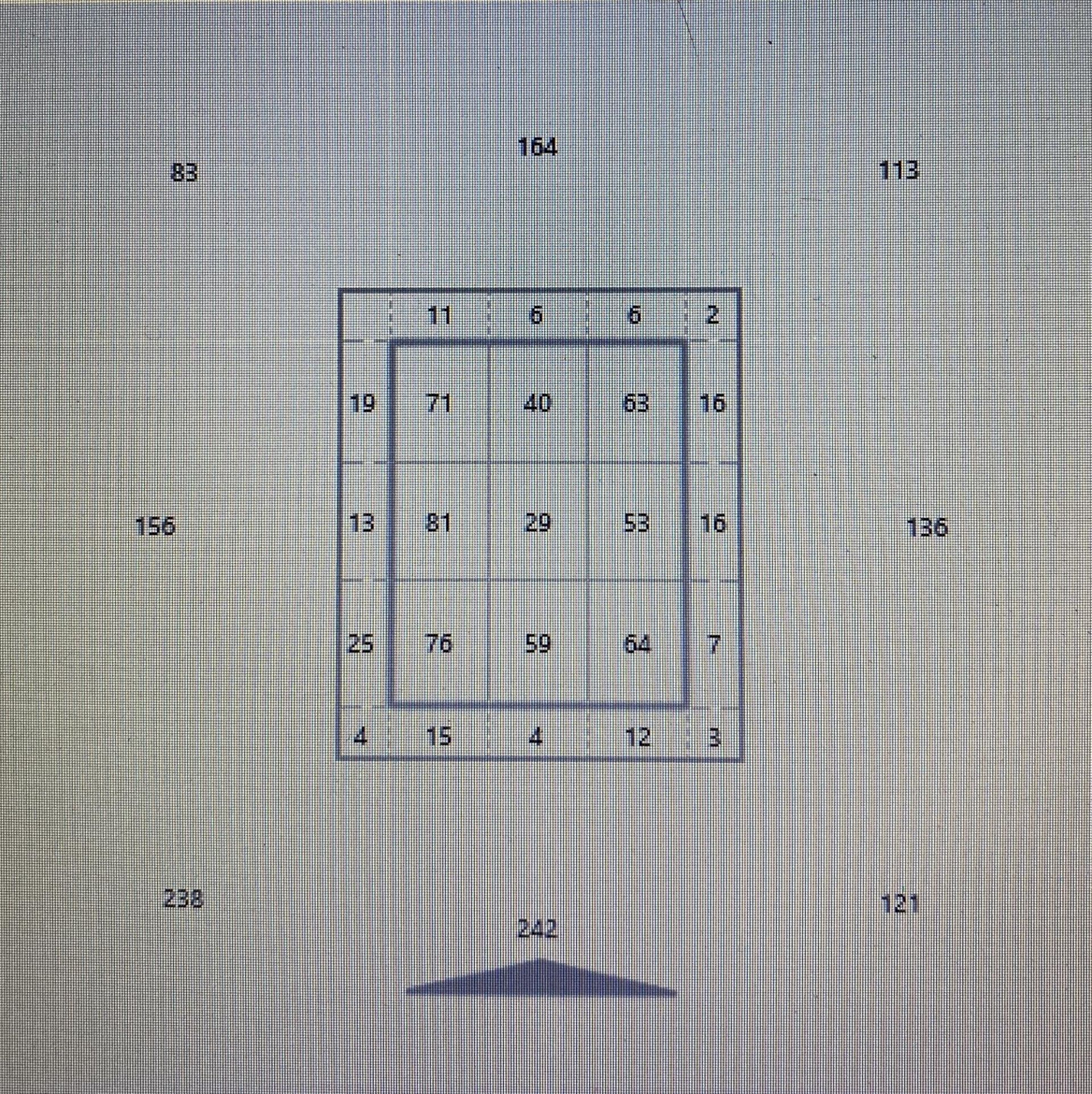
When developing the philosophy and reasoning on why we get into our optimal receiving stance majority of the time, we must study the zones and see how often pitches are thrown in different spots. Tanner Swanson went into depth on this subject in one of his recent Zoom webinars, but Pitchers are becoming more apt to throwing secondary pitches more frequently.
Secondary pitches normally are called in the bottom of the zone. Pitches called to the bottom of the zone also have a chance to be thrown in the dirt. This optimal receiving stance (knee-down position) benefits us greatly when looking at where pitches are thrown. Mitch Garver (Twins Major League Catcher) stated that being this knee-down position allows him to make a better judgment decision on whether a pitch is in dirt or if he can stay underneath the pitch and present it back in the zone. This optimal receiving stance also allows us to excel at where pitches are frequently thrown.
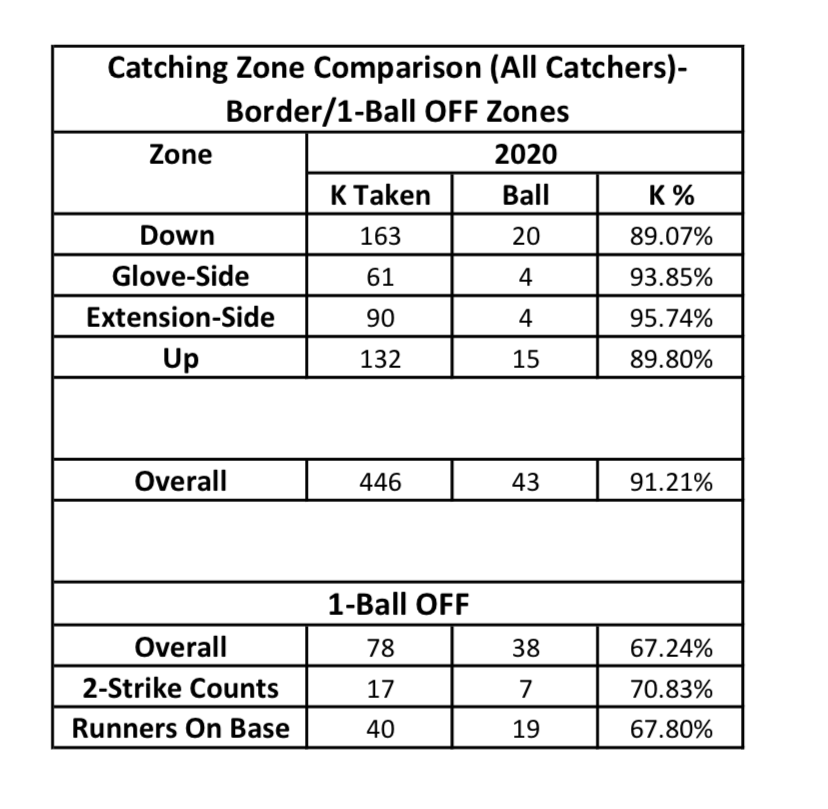
Chart to the above displays data from this 2020 season. We took the philosophy of getting into our optimal receiving stance as often as we could. This allowed us to be successful in winning strikes for our Pitching Staff. This means that our Pitchers were getting into more advantage counts and putting the hitter in a defensive position.
Also, if one looks at the 1-ball off zones. Two-Strike counts and when runners are on base, traditionally coaches like for Catchers to get into big Secondary stances. When pitches were thrown in the 2 strike counts, we stayed in the receiving first mindset and won those pitches that were 1-ball off at a 70% success rate. This meant that 7 out of 10 times, if our Pitcher threw a pitch that was 1-ball off, we had a receiving first mindset to win that pitch and in return we ended at-bats early via the strikeout at that rate.
In comparison with runners on base, we won the pitches that were outside of the strike zone and 1-ball off at a 67% success rate. This meant we were moving to pitcher leverage counts 67% of the time when our opposition had runners on base and were threatening to score.
In conclusion of this data, we must realize how often skills happen and how we as Catchers can help our team win that specific game. Once we realize what exactly that is, then practice it, perfect it, and perform it!
Situation (above video): Runners in scoring position. 2-strike count on hitter. Slider is the pitch call. We could get into a tall/big stance, but we understand where the impact of the game comes from, and we stay in the receiving-first mindset. The reason for this is because we can stay in the frame of mind and potentially end the at-bat by receiving the pitch the correct way in the optimal receiving stance.
Lastly, an aspect of studying this data includes the main priority of catching, handling the Pitching Staff. Communication with the pitching staff must be effective and purposeful. I would highly advise to have the Catchers ask individual pitchers what they particularly like from a setup position. The different variations of all stances can have a positive or negative effect on the Pitching Staff, but that is the whole reason we’re here. That reason being that we must empower and instill confidence in our pitcher.
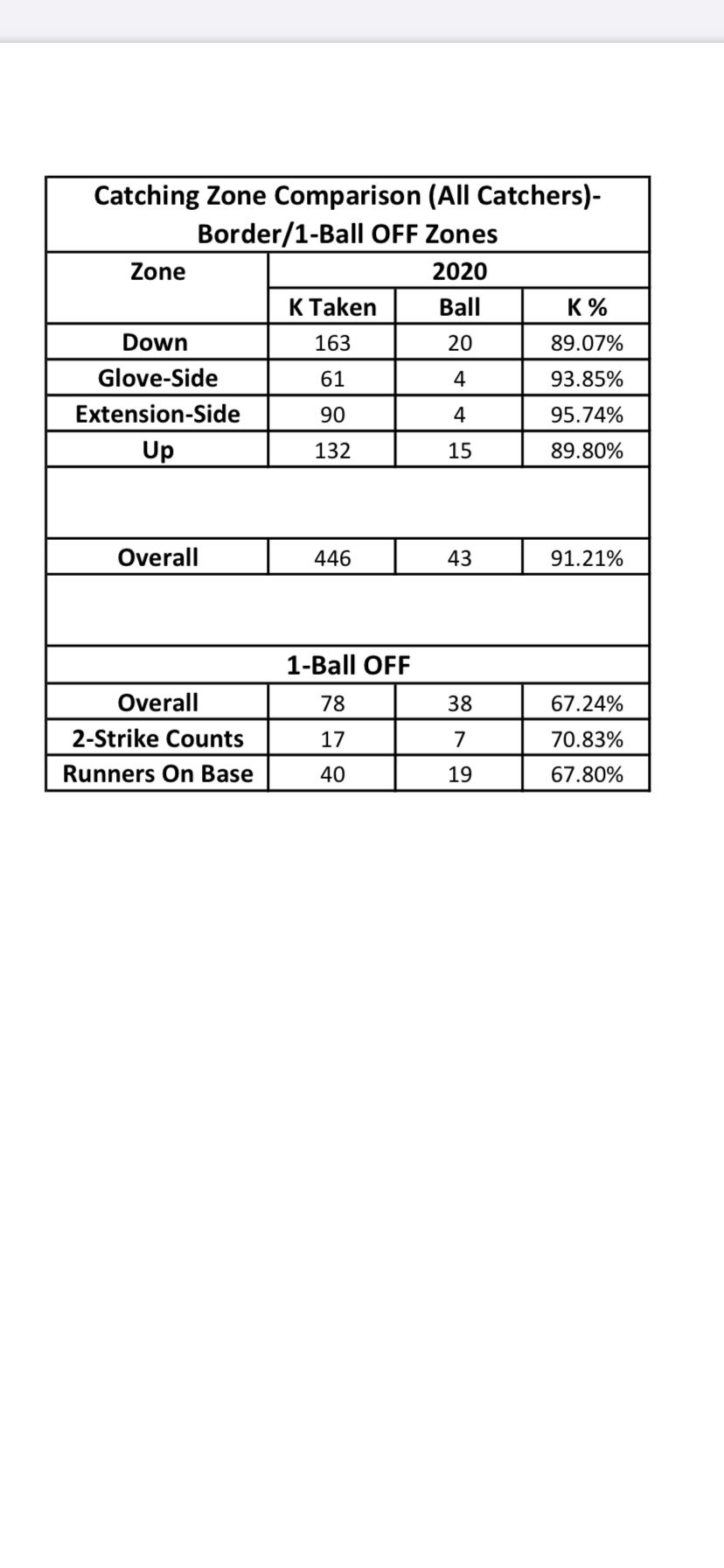
Application
This strategy of the “receiving first mindset” and empowering Catchers to throw/block out of their optimal receiving stance can be difficult to implement if there is no direction with the plan. Communication with each individual Catcher is also critical. Catchers will each respond to a different set of physical/verbal cues. Us as Coaches must effectively communicate the task at hand and figure out what is exactly their optimal receiving stance and how are they going to perform other skills out of this stance. The analogy I always fall back on and refer to is that we, as coaches must build the playground with a fence for the Catchers and then we let them play in it as they choose. We give the perspective, info, drills, etc. to be successful and then let the Catchers feel what works for them so that they can perform at their optimal level.
In a drill setting, we have incorporated a few ways to improve our craft and how to have as game-like practice as possible. A drill I love to do is giving the Catchers certain situations. For example, we will have a Hack Attack setup 60 ft away and is throwing a RHP Breaking Ball. I will give them a scenario (Plus runner on 1st, 0 outs, we’re winning 5 to 2). I will then have the Hack Attack throw breaking balls whether they are bounced, in the middle of the zone, or in a border zone. We will video, chart success, and analyze in a one-on-one conversation. This is seeing our Catcher react to pressure situations. I’m a firm believer that the same pot of boiling water that hardens an egg also softens a carrot. Different cues are going to work for different guys. Explain the situation to them and how they are going to be able to impact the game.
Another drill to practice this we utilize is with a Runner on 1st from our Right-Knee down variation or Hybrid Stance. The Right-knee down variation is one Mitch Garver uses where we are in the optimal throwing position to start.
We read the runner, and if the runner does not attempt to steal, we simply extend the left leg out and now we are in our optimal receiving stance. The Hybrid Stance is quite similar except it is for guys who are comfortable with the traditional secondary stance. If a runner goes, they stay in their traditional secondary stance to throw. On the contrary, if a runner doesn’t go, they adjust into their optimal receiving stance via either a “knee drop” or with a “jump” variation similar to what J.T. Realmuto utilizes. For the drill, Hack Attack is set up with a pitch being thrown. As pitch is being inserted into the Hack, we shout “Runner” “Going” (whatever terminology your club uses). This will force them to simulate adjusting into their throwing stance and perform a throw. If nothing is shouted, they use the variation into their optimal receiving stance and win the pitch.
The Hybrid Stance is quite similar except it is for guys who are comfortable with the traditional secondary stance. If a runner goes, they stay in their traditional secondary stance to throw. On the contrary, if a runner doesn’t go, they adjust into their optimal receiving stance via either a “knee drop” or with a “jump” variation similar to what J.T. Realmuto utilizes.
In a drill setting, we have incorporated a few ways to improve our craft and how to have as game-like practice as possible. A drill I love to do is giving the Catchers certain situations. For example, we will have a Hack Attack setup 60 ft away and is throwing a RHP Breaking Ball. I will give them a scenario (Plus runner on 1st, 0 outs, we’re winning 5 to 2). I will then have the Hack Attack throw breaking balls whether they are bounced, in the middle of the zone, or in a border zone. We will video, chart success, and analyze in a one-on-one conversation. This is seeing our Catcher react to pressure situations. I’m a firm believer that the same pot of boiling water that hardens an egg also softens a carrot. Different cues are going to work for different guys. Explain the situation to them and how they are going to be able to impact the game.
Another drill to practice this we utilize is with a Runner on 1st from our Right-Knee down variation or Hybrid Stance. The Right-knee down variation is one Mitch Garver uses where we are in the optimal throwing position to start.
For the drill, Hack Attack is set up with a pitch being thrown. As pitch is being inserted into the Hack, we shout “Runner” “Going” (whatever terminology your club uses). This will force them to simulate adjusting into their throwing stance and perform a throw. If nothing is shouted, they use the variation into their optimal receiving stance and win the pitch.
Final Thoughts
One huge takeaway from this is to chart and track success. We will have no idea if our Catchers are getting into their optimal receiving stance and if they can perform the other skills from that stance if we aren’t tracking it. In my opinion, I would create a chart that is user friendly obviously and can chart it manually in practice while videoing to have visual feedback. It is critical to communicate to the Catcher the reasoning behind getting in this stance for him to realize where his impact can be on the game. Overall, this isn’t the only way to catch. This is just, in my opinion, the most effective way to save runs from the Catching position based on skills that happen throughout a game-setting.
Huge thanks to Zac Stout and everyone else for putting this platform together. It is a great way to share content and to learn on how the Catching position is evolving. Invite all coaches for this site as there is a large amount of info to help your Catchers perfect their craft and the library for content is only growing. Once again, thanks to Zac Stout for letting me share this study and data. I hope you learn something from reading this post and feel free to reach out with any questions!
*Data is from in-game charts/synergy
*Run-Value Chart is from Zac Stout
Want more great
Catching Content?
Sign up for FREE and see everything we have to offer!


